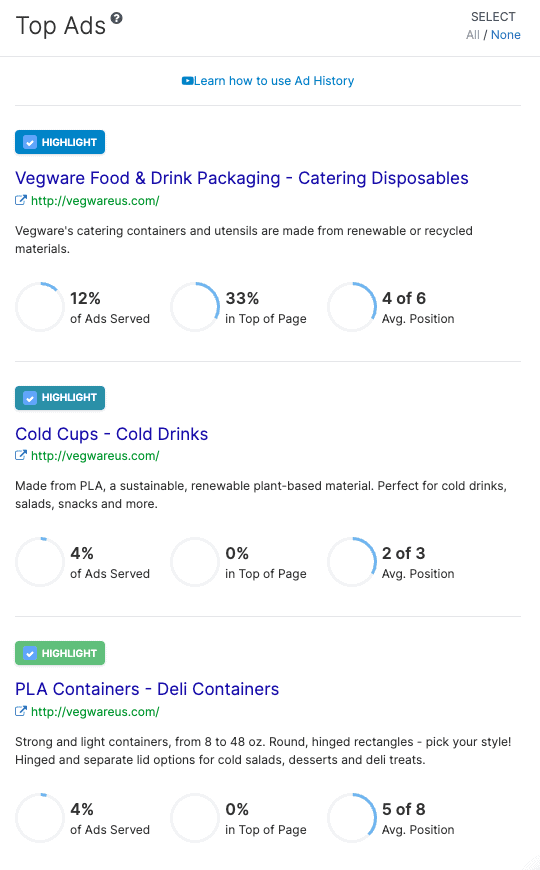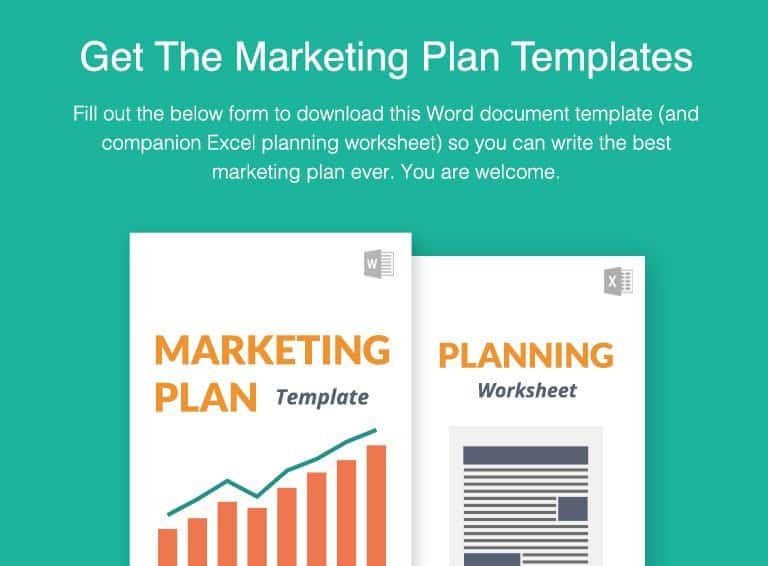Trying to market your business without a plan is a little like going on a road trip without GPS. You’ll end up somewhere, but it’s anyone’s guess where — and you might find yourself worse off than when you started.
Let’s not let that happen.
In this article, newly updated for 2023, we’ll give you all the information you need to write a marketing plan — plus a free template and planning worksheet you can use to help ensure that your business gets where it needs to go. We’ll be focusing on digital marketing, but the strategies and concepts can be expanded to encompass your entire marketing department.
9 Reasons You Need a Marketing Plan
For today’s marketers, creating an integrated marketing plan that includes paid digital marketing (PPC), social media marketing, content marketing, email marketing, and SEO — all tenets of a strong inbound marketing strategy — is necessary in order to attract and convert new customers online.
Here are nine important benefits of creating a marketing plan:
- Goal Setting: A marketing plan will help your business define its marketing objectives and set measurable goals. It provides a clear roadmap of what you aim to achieve in terms of lead generation, sales, market share, brand awareness, customer acquisition, or other specific targets.
- Strategic Direction: A good marketing plan outlines the overall strategy and approach that your business will take to promote its products or services. It will help you identify your target audience, understand their needs and preferences, and develop strategies to effectively reach and engage them.
- Budgeting and Resource Allocation: A marketing plan assists in effectively allocating resources such as budget, personnel, and time. It will help your team prioritize marketing activities and distribute resources based on their importance and potential return on investment (ROI).
- Market Analysis: A marketing plan requires you to conduct thorough market research and analysis. This process will help you gain insights into the state of the market you’re in, including customer demographics, behavior, competitors, and industry trends.
- Competitive Advantage: When you create a marketing plan, you’ll define and leverage your unique selling proposition (USP) or competitive advantage. This will empower you to position your products or services effectively in the market and differentiate yourself from competitors, leading to a stronger market presence.
- Consistency and Integration: A marketing plan ensures consistency in branding, messaging, and customer experience across various marketing channels and touchpoints.
- Risk Mitigation: Developing a marketing plan will help your business anticipate potential risks and challenges in the market. By analyzing market conditions, competitive threats, and changing customer needs, you will be able to proactively develop strategies to mitigate risks and adapt to market dynamics.
- Measurement and Evaluation: A marketing plan establishes key performance indicators (KPIs) and metrics to measure the effectiveness of marketing initiatives. It provides a framework for tracking and evaluating marketing performance, enabling you to identify successful strategies, make data-driven decisions, and continuously improve your marketing efforts.
- Long-term Sustainability: A well-structured marketing plan paves the way to long-term growth and sustainability. It promotes a strategic mindset, encourages proactive marketing initiatives, and ensures that your business stays responsive to changing market conditions, customer demands, and emerging trends.
The steps you take today to create a functional and straight-forward marketing plan will lay the foundation for your year ahead, helping you to achieve measurable, quantifiable results.
Let’s take a look at how your marketing plan should be structured.
Marketing Plan Outline
Here are the 11 sections that should be in every digital marketing plan.
- Business Summary: Provide an overview of your business, including your headquarters, mission statement, and members of your marketing team.
- Executive Summary: Highlight key points of your marketing plan for easy reference.
- Business Goals: State what overarching business goals your marketing activities will support.
- Market Analysis: Provide information about the current state of the market as it pertains to your business. Include a SWOT analysis identifying your company’s strengths, weaknesses, opportunities, and threats.
- Competitive Analysis: List your main competitors, along with relevant information about their brands and positions in the marketplace.
- Target Market: Include detailed buyer’s personas that cover the types of buyers you will be marketing to.
- Unique Selling Proposition (USP): Explain what sets you apart from the competition in a way that leads your audience to choose you over the others.
- Marketing Initiatives: Identify the major marketing initiatives or projects you will focus on in order to support your business’ overarching goals.
- Marketing Channels: Explain what channels you will use to launch your marketing initiatives.
- Measurements and KPIs: Detail how you’ll be tracking the progression of your marketing plan.
- Budget: How much money will the business allocate to the year’s marketing activities?
How to Create a Marketing Plan
Now that you know what to include in your marketing plan, let’s dive into the step-by-step process of creating one.
1. Write your business summary
In theory, this should be the easiest step in creating your marketing plan. That’s because everything this section contains pulls from information many companies already have documented, including creative marketing ideas. However, it’s not uncommon to discover some gaps when the time comes to sit down and start writing. Here is what you should include in your business summary:
- Company name
- Headquarters
- Brief overview of what market category your company is in and what products or services you provide
- Mission statement
- Marketing team members
Pretty straightforward — unless your company lacks a mission statement. If that’s you, now is the time to create one. Start with your business overview. That might look something like this example for a fictional company:
“Eco Eats manufactures 100% biodegradable, compostable disposable plates, cutlery, cups, and straws.”
Next, ask “why?” What is the purpose of your business? What problem are you trying to solve? What’s your vision for the future?
Once you have your “why,” move on to your “how.” What concrete actions is your company taking to achieve your purpose?
Put the two together, and you have a mission statement. Here’s an example mission statement for Eco Eats:
“At Eco Eats, our mission is to empower food service organizations to reduce their carbon footprint and contribute to the stewardship of our environment by providing a cost-effective alternative to single-use plastics.”
Your mission statement might be a little longer or a little shorter, but you should strive to make it as simple and easy-to-understand as possible.
2. Do your market research
In order to write an effective marketing plan, you need to understand the climate of the market you’re operating in. This includes the size of the market — dollars spent, quantity of products sold, and overall number of customers or consumers — as well as any trends and conditions that are affecting the market, for better or for worse. Even if you’ve done this sort of research before, you’ll need to refresh it yearly for your marketing plan.
Along with this general information, the Market Analysis section of your plan should include an analysis of your company’s current status in the market. To get there, you’ll include what’s known as a SWOT analysis, detailing your business’ strengths, weaknesses, opportunities, and threats.
A SWOT analysis is a standard component of any business or marketing plan. The SWOT analysis will help you understand what differentiates you from your competition and how you should position yourself in the market. It will also help you develop your messaging and your unique selling proposition. Brutal honesty is imperative for a truly insightful SWOT. Use bullets and aim for 4-5 in each section. Limiting your lists will help you to focus on the most critical points and help retain focus.
In addition to completing a SWOT for your overall marketing plan, it’s helpful to do a SWOT analysis for the different segments within your marketing plan.
For example, as we will discuss further down in this piece, content marketing, social media, and SEO will all be important parts of your overall inbound marketing plan and would benefit from SWOTs of their own.
3. Research the competition
In order to determine the likelihood of success and define your marketing strategy, you need to understand the competition. In the world of digital marketing, there are a handful of strategies that can be useful when researching competitors. Using email and social media while surveying the content landscape will give you an immense amount of knowledge about your industry.
Here are some quick tips to help you understand who you’re up against:
- Subscribe to receive your competitors’ emails.
- Follow your competitors on Twitter, Facebook, LinkedIn, Instagram, and any other social media site where you can find them.
- Examine what content your competitors are creating — who it is aimed at, how often it’s produced, who is writing it, what the content topics are, etc.
- Use a tool like SpyFu to identify what keywords your competitors are ranking for organically and targeting with paid search advertising (PPC).
Here’s an example of some competitive research for our fictional company Eco Eats, showing the top performing paid search ads for a (real) company that produces plant-based food and beverage packaging. You can use research like this to inform your own paid search strategy.
It’s important to note that many companies have two different kinds of competitors: those you compete against for actual customers and digital marketing competitors. Digital marketing competitors are companies that target the same keywords and/or audience segments online. While you might not directly lose customers to these competitors, they can make it harder for you to meet your goals for website traffic, conversions, and online leads. Both types of competitors should be accounted for in the Competitive Analysis section of your marketing plan.
For more on digital marketing competitors, read up on Competitive Research in SEO from Moz.
4. Create buyer personas
When it comes to writing your digital marketing plan, creating buyer personas will help you understand:
- Who you are marketing to
- What their pain points are
- Where they spend time online
- And a number of other demographic traits
This information will help you personalize your marketing materials so they are targeted and highly relevant to your audience segments.
Remember: You aren’t trying to catch every fish in the sea. You’re only trying to catch the ones you want, the ones you are targeting because they have the strongest potential to turn into leads. Your net doesn’t need to be wide — it needs to be precise.
For more guidance on this step of creating your marketing plan, check out our guide to creating buyer personas.
5. Write your unique selling proposition (USP)
Now that you know all about the market, your competitors, and your buyers, it’s time to turn inward and create a USP. This section of your marketing plan defines what makes you different and better than your competition, and why your target audience should choose to buy from you. Knowing and communicating your USP is critical if you want to beat your competition and solidify your company’s value in the marketplace.
Like the rest of your marketing plan up to this point, your USP should be revisited at least once a year. What made you stand out when your business was founded may not hold the same value in today’s market.
For tips on formulating your USP, check out The Ultimate Guide to Finding Your Unique Selling Proposition.
6. Define your goals
If you’ve been following along since our marketing plan outline, you may have noticed that we skipped a few of the items on the list: the executive summary and the goals. That’s because, while the executive summary is the second section of your marketing plan, you can’t actually write it until you’ve created the rest of the plan. And it’s important to do the research steps we’ve already covered before you move on to setting goals.
Your goals should start with the high-level outcomes your business needs to achieve in order to support sustainable growth. In digital marketing terms, that usually means increasing online leads and/or sales by a certain percentage. You can then break those high-level goals down into sub-goals that will help ensure your overall success. For example, if you want to increase your leads, sub-goals might be:
- Increase website traffic by 50%
- Increase online conversion rate by 25%
Be sure not to confuse goals with tactics. If your goals are what you want to achieve (e.g. to increase traffic by 50%), your tactics are the steps you’ll take to reach your goals. Creating a content marketing calendar to rank organically for more high-value keywords is an example of a tactic that will help increase site traffic. Your tactical plan is the next step in writing your marketing plan.
7. Describe the initiatives and projects you’ll undertake to achieve your goals
We just gave one example of a tactical project you might include in your marketing plan — creating a content marketing calendar. To complete this step in writing your plan, you’ll examine each of your strategic goals and create your roadmap for how to get there. Other examples of digital marketing initiatives and projects that might be included in a marketing plan include:
- A website redesign to improve user experience (UX) and increase conversion rates
- A paid advertising (PPC) initiative to drive traffic, promote your content, and increase conversions
- An email lead nurture campaign to increase calls to your sales team
In your marketing plan, you should name each initiative or project along with a description of the steps you’ll take to complete it. Make sure to define what success looks like so your team has a clear destination in mind.
8. List your marketing channels
For each of your tactical projects or initiatives, provide information about where and how you’ll launch them. Some projects might have only one marketing channel associated with them — for example, email marketing. Others might have multiple channels. Examples of digital marketing channels include:
- Pages on your website
- Your blog
- Your website’s resource center
- Guest blogging
- Paid search advertising on Google, Bing, or other search engines
- Paid display advertising on Google’s display network
- YouTube videos and/or advertising
- Organic and/or paid social media
9. Create your plan for tracking, measuring, and reporting on success
Each of your marketing initiatives should be associated with measurable key performance indicators (KPIs) that you’ll track and report on in order to determine what’s working and what’s not. This is a critical component of your marketing plan. Here are some examples of KPIs you might want to report on:
- Email open rate, click rate, click-through rate, and response rate
- PPC cost per click, conversion rate, and leads and/or revenue generated
- Organic keyword rankings
- Website traffic by page
- Video engagement
When at all possible, set up full-funnel attribution for your initiatives so that you can track which interactions actually lead to increases in sales and revenue. In fact, even before you have implemented your strategy, you should be measuring to establish your baseline. What have you done in the past and what were the results? How can those strategies shift to improve ROI?
It’s important to note that you should plan on reporting on your KPIs at least monthly — and as often as weekly for rapidly changing metrics like PPC and email results. (It typically takes much longer for organic rankings to show results.) And don’t be afraid to change course based on what your reports tell you.
10. Set your budget
Beginning with your overall marketing budget, the next step in writing your marketing plan is to determine how much money to allocate to each marketing initiative and platform. Be sure you have enough available to achieve the results you want in each area. If you’re not sure what your marketing budget should be, you can benchmark against other businesses in your industry, or start from the very rough “rule of thumb” of spending 10% of your expected revenue on marketing — and then adjust for the realities of your business.
In general, your budget will depend on factors such as:
- Stage of development (start-ups may need to spend a higher percentage of their projected revenue on marketing than long-established businesses)
- Company revenue
- Overall expenses
- Brand awareness (the less people are aware, the more you’ll need to spend on marketing)
- Marketing goals and initiatives
Like your marketing plan as a whole, your budget should have some flexibility built into it in order to respond to what’s working throughout the year. For example, if your paid advertising campaigns are demonstrating strong, measurable increases in revenue, you’ll want to double down and increase your PPC budget accordingly. Or, on the other hand, you may realize that your budget for content marketing isn’t sufficient to get the results you want. You’ll either need to increase the budget or revise your content marketing strategy.
For more guidance, read our post on planning a marketing budget (with a handy template).
11. Write your executive summary
Now that you’ve done all the hard work of researching and planning your marketing goals, initiatives, platforms, and budget, it’s time to sum it all up for easy reference. The executive summary is the second section of your marketing plan, and it is arguably one of the most important components.
That’s because the plan itself is a pretty lengthy document, and it’s going to be read by different people in different roles, from your CEO to your marketing agency partners to your investors, and so on. It’s important to give everyone an easy-to-understand overview to increase the chances that they’ll actually read the whole thing, and that they’ll understand the big picture when they do.
Your executive summary should be one or two pages long. Here’s what to include:
- Overview: Write a compelling introduction setting the stage for your marketing plan. Treat this section as a short, engaging narrative that tells the story of where your company stands, where it’s going in the next year, and what role marketing will play in that journey.
- Market Summary: Explain the main findings from your market analysis and competitive research.
- Customer Summary: List your different buyer persona types along with a summary of their buyer’s journey with respect to your company’s products and services. How do they become aware of the problems or pain points you solve? How do they go about researching solutions? How will you reach them, and why will they choose your brand over the competition?
- Budget Breakdown: Provide your overall marketing budget and a line-by-line breakdown by initiative.
- Goals and Strategies: Briefly summarize your marketing goals and the high-level strategies for achieving them.
- Conclusion: Wrap it up with a few sentences to encourage your audience to read the entire plan.
There is a lot that goes into creating a marketing plan. But when it’s done right, it will be the most valuable asset your marketing department has.
Download Our Free Marketing Plan Templates
As we like to say at Vital, “Plan the work; work the plan.” To help get you started, we have included a marketing plan template with accompanying Excel calendars so you can plan and track throughout the year.
At Vital we believe in digital marketing because we’ve seen the results first hand. It is how we market our business and how we market our clients’ businesses. If you would like help in developing your digital marketing plan, give us a shout.








